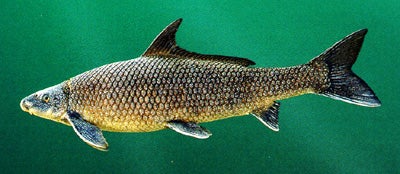SCIENTIFIC NAME: Cycleptus elongates
CHARACTERISTICS: The blue sucker has an elongate, cylindrical body, a short head, and a small mouth covered with many small papillae. The dorsal fin contains 29 to 37 soft rays, and its free edge is sickle-shaped. The caudal fin is large and deeply forked. The ventral fins are bowed downward, with lower edges that are often calloused from rubbing on submerged structures. Individuals are pale to dark blue, with brown mottling on the back shading to light gray on the venter. On spawning adults, body colors intensify, and the body, head, and even fins become covered with hundreds of small, white breeding tubercles. According to Richard L. Mayden and Brooks M. Burr, blue suckers in the Mobile basin may represent a new species. See Lesueur (1817b) for original description.
ADULT SIZE: 24 to 35 in (610 to 890 mm)
DISTRIBUTION: The range of this species has expanded substantially since 1993 because of the collective efforts of the Alabama Wildlife and Freshwater Fisheries Division, the Geological Survey of Alabama, the U.S. Fish and Wildlife Service, and Alabama Power Company. The nine blue suckers we collected in 1993 at Alabama River mile 6.2 represent a new downstream range limit in the Mobile basin, except for a waif reported from Dauphin Island by Swingle (1971). The status of populations in the Tennessee River drainage is unclear, since individuals are recorded from only two locations, one in 1939 and the other in 1993.
HABITAT AND BIOLOGY: An excellent example of a habitat specialist, the blue sucker is limited in Alabama to large flowing rivers and tailwaters below dams. Data obtained from more than 125 blue suckers captured and released below Millers Ferry Lock and Dam on the Alabama River in 1995 indicated that the species spawns in early April. Females slightly outnumbered males in March and April and abandoned the area by May. Sonar tagging and tracking studies completed in 1996 indicated that, following spawning, individuals move over 100 miles downstream, well below Claiborne Lock and Dam. Yeager and Semmens (1987) artificially spawned ripe blue suckers collected from the Alabama River and subsequently described the species’ early development from protolarva to juvenile. Knowledge of the early life history of this species in Alabama is incomplete. Rupprecht and Jahn (1980) report that blue suckers live 10 years in the Mississippi River and attain a maximum length of 32 inches.
ORIGINAL DESCRIPTION: The blue sucker was described by Lesueur in 1817.
ETYMOLOGY:
Cycleptus means small, round mouth.
Elongates means elongate.
The copyrighted information above is from Fishes of Alabama and the Mobile Basin.






